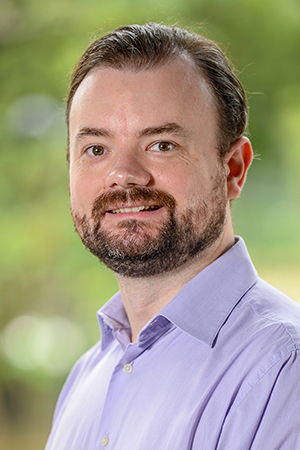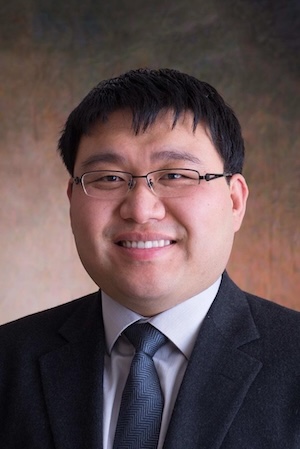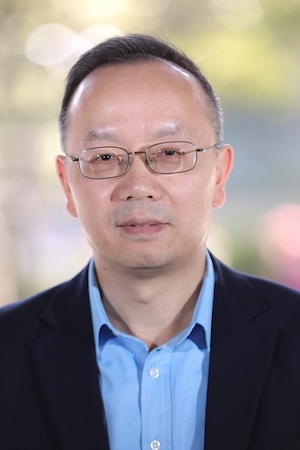NYU Shanghai, in partnership with the NYU Graduate School of Arts and Science (GSAS) and the NYU Department of Chemistry, invites applications from exceptional students for PhD study and research in Chemistry.
Participating students are enrolled in the NYU GSAS Chemistry PhD program, complete a portion of their coursework at the NYU Department of Chemistry in New York, and then transition to full-time residence at NYU Shanghai where they finish their coursework and undertake doctoral research under the supervision of NYU Shanghai faculty.
Highlights of the Program
- NYU PhD degree in Chemistry upon graduation
- Graduate coursework at the NYU Department of Chemistry in New York and NYU Shanghai
- Research opportunities with and close mentorship by NYU Shanghai faculty
- Access to the vast intellectual resources of NYU GSAS and NYU Department of Chemistry
- Cutting-edge research environment at NYU Shanghai, including the Center for Computational Chemistry, activities such as a regular program of seminars and visiting academics, a thriving community of PhD students, post-doctoral fellows, and research associates, and links with other universities within and outside China
- Financial aid through the NYU Shanghai Doctoral Fellowship, including tuition, fees, and an annual stipend
- Additional benefits exclusive to the NYU Shanghai program, including international health insurance, housing assistance in New York, and travel funds
Supervising Faculty

William Glover
Theoretical Photochemistry and Photobiology, Quantum Chemistry

Xiang Sun
Theoretical Chemical Physics, Quantum Dynamics, Statistical Mechanics, Ultrafast Spectroscopy

John Zhang
Protein-Protein Interaction, Computational Drug Design, Protein Dynamics
Representative Publications by NYU Shanghai Faculty
William Glover
Alexander Humeniuk, William J. Glover, Multistate, polarizable QM/MM embedding scheme based on the direct reaction field method: Solvatochromic shifts, analytical gradients and optimizations of conical intersections in solution, J. Chem. Theory Comput. 20, 2111-2126 (2024)
Amiel S. P. Paz, William J. Glover, Efficient analytical gradients of property-based diabatic states: Geometry optimizations for localized holes, J. Chem. Phys. 158, 204107 (2023)
Xingpin Li, Xiangyu Jia, Amiel S. P. Paz, Yuquan Cao, William J. Glover,* Evidence for water antibonding orbital mixing in the hydrated electron from its oxygen 1s X-ray absorption spectrum, J. Am. Chem. Soc. 144, 19668-19672 (2022)
Yuanming Bai, Leslie Vogt-Maranto, Mark E. Tuckerman, William J. Glover,* Machine learning the Hohenberg-Kohn map to molecular excited states, Nat. Commun. 13, 7044 (2022)
Zhuofan Shen, Shaoting Peng, William J. Glover,* Flexible boundary layer using exchange for embedding theories. II. QM/MM dynamics of the hydrated electron, J. Chem. Phys. 155, 224113 (2021)
Xiang Sun
Zengkui Liu, Xiang Sun*, Direct All-Atom Nonadiabatic Semiclassical Simulations for Electronic Absorption Spectroscopy of Organic Photovoltaic Chromophore in Solution, J. Phys. Chem. Lett. 16, 4463-4473 (2025).
Hao Zeng, Yitian Kou, Xiang Sun*, How Sophisticated Are Neural Networks Needed to Predict Long-Term Nonadiabatic Dynamics? J. Chem. Theory Comput. 20, 9832-9848 (2024).
- Zengkui Liu, Zailing Song, Xiang Sun*, All-Atom Photoinduced Charge Transfer Dynamics in Condensed Phase via Multistate Nonlinear-Response Instantaneous Marcus Theory, J. Chem. Theory Comput. 20, 3993-4006 (2024).
Zhubin Hu, Xiang Sun*, All-Atom Nonadiabatic Semiclassical Mapping Dynamics for Photoinduced Charge Transfer of Organic Photovoltaic Molecules in Explicit Solvents, J. Chem. Theory Comput. 18, 5819-5836 (2022).
Tao Wang, Zhubin Hu, Xiancheng Nie, Linkun Huang, Hui Miao, Xiang Sun*, Guoqing Zhang*, Thermochromic Aggregation-Induced Dual Phosphorescence via Temperature-Dependent sp3-Linked Donor-Acceptor Electronic Coupling, Nat. Commun. 12, 1364 (2021).
John Zhang
Huang, K.F; Duan, L.L and Zhang, J.Z.H., From Implicit to Explicit: An Interaction-Reorganization Approach to Molecular Solvation Energy, J. Chem. Theor. Comput. 20, 10961-10971 (2024).
Li, X.T; Mi, S.X.; Xu, Y.Z.; Li, B.W.; Zhu, T and Zhang, J.Z.H., Discovery of New Synthetic Routes of Amino Acids in Prebiotic Chemistry, JACS Au. 4, 4757-4768, (2024).
Gan, Z.J.; Feng, J.Q.; Yin, J.B.; Huang, J.P.; Wang, B.J.; Zhang, J.Z.H., Diverse Mechanisms for the Aromatic Hydroxylation: Insights into the Mechanisms of the Coumarin Hydroxylation by CYP2A6, ACS Catalysis, 14, 16277-16286(2024).
Zhao, F.; Xia, W.; Wang, Y.; Hu, S.; Zhang, X.; Zhang, J. Z. H., Prediction of Potential Drug-Resistant ALK Mutations against Fourth-Generation Inhibitors NVL-655 and TPX-0131. Int. J. Bio. Macromol. 321, 146212 (2025).
Wu, X.; Zhang, X.; Xia, W.; Zhang, Y.; Huang, K.; Zhao, F.; Ji, C.; Wang, J.; Zhou, B.; Zhang, J. Z. H., Discovery of Novel Cytochrome Bd Oxidase Inhibitors against Mycobacterium Tuberculosis. European J. Med. Chem. 298, 118010 (2025).
Selected Faculty and Student Features
“Students and Scholars Gather for 2025 Summer School on Machine Learning and Artificial Intelligence for the Molecular Science at NYU Shanghai” (William Glover, Sun Xiang, John Zhang)
“Chemistry Faculty Xiang Sun Wins Prestigious Research Grant” (Xiang Sun)
“NYU Shanghai Joint Team Leads Global Drug Challenge with Top Hit Rates” (Lei Zheng, John Zhang)
“NYU Shanghai Hosts Frontier Symposium on Theoretical and Computational Chemistry” (William Glover, Xiang Sun, John Zhang)
"Cover article: New Computational Technique Investigates Charge Transfer in DNA" (Amiel Paz, William Glover)
"NYU Shanghai PhD Student Wins Best Poster at Chinese Chemical Society Congress" (Zengkui Liu, Xiang Sun)
"Communicating Science: NYU Shanghai’s First Postdoctoral and Doctoral Research Assembly" (Shiyu Hu, Fanyu Zhao)
"Dialogue with Directors: Pushing the Boundaries of Research Through Interdisciplinary Collaboration" (William Glover, John Zhang)
"Scientists Develop Artificial Intelligence to Predict Photochemical Reactions" (William Glover, Yuanming Bai)
"Professor William Glover Wins OpenEye Outstanding Junior Faculty Award in Computational Chemistry" (William Glover)
"New NYU Shanghai Study Explores the Nature of Hydrated Electrons" (William Glover, Xinping Li)
"NYU Shanghai Scientists Propose New Approach for Charge Transfer Rate Calculation" (Xiang Sun, Zengkui Liu)
"NYU Shanghai Researchers Construct New Models for Energy Transfer Simulation" (Xiang Sun, Dominikus Brian)
“Professor John Zhang elected as Fellow of the Royal Society of Chemistry” (John Zhang)
Structure of Program
Participating students complete the PhD degree requirements set by the NYU Department of Chemistry and in accordance with the academic policies of NYU GSAS. Each student develops an individualized course plan in consultation with the Director of Graduate Study at the NYU Department of Chemistry and the student’s NYU Shanghai faculty advisor. Most students will complete their PhD in 5 years. A typical sequence follows:
in Shanghai
border
Begin program with funded summer research, up to 3 months preceding first Fall semester, to familiarize with NYU Shanghai and faculty as well as lay a foundation for future doctoral study.
in New York
border
Pursue PhD coursework at Department of Chemistry alongside other NYU PhD students.
border
Complete PhD coursework and conduct research rotations with NYU Shanghai faculty. Select PhD advisor and make further progress in research during the summer in Shanghai.
in Shanghai
border
Under supervision of NYU Shanghai faculty advisor, pursue dissertation research. Complete all required examinations and progress evaluations, both oral and written, leading up to submission and defense of doctoral thesis.
To learn more about the NYU Chemistry PhD program degree requirements, please visit this page.
Current Students
| Name | Research Areas |
| Shiyu Hu | Bioinformatics, Machine Learning, Drug Design, Protein Interactions |
| Yuquan Cao | Quantum Chemistry, Photochemistry, Excited States |
| Zengkui Liu | Quantum Effects in Spectroscopy and Charge Transfer Dynamics |
| Fanyu Zhao | Machine Learning, Quantum Chemistry, Drug Design |
| Lei Zheng | Drug Discovery, Machine Learning, Molecular Dynamics |
| Yuzhi Xu | Machine/Deep Learning in Chemistry, Protein Structure Prediction |
| Raj Roy | Non-adiabatic Dynamics, Electronic Structure Theory, Excited State Properties |
| Jialong Wang | Charge Transfer Dynamics and Polaritonic Chemistry |
| Wei Xia | Drug Design, Protein Ubiquitination and Degradation, Protein-Protein Interactions |
| Tingyao Lu | Nuclear Quantum Effects in Excited-State Dynamics |
| Zailing Song | Organic Photovoltaics and Nonadiabatic Dynamics |
| Zihan Zou | Machine Learning, Nonadiabatic Dynamics, and Spectroscopy |
Alumni
| Name | Placement |
| Yuanming Bai, PhD '23 | Research Scientist at Solvay, China |
| Xingpin Li, PhD '23 | Chemistry Olympiad Coach at Xishan Senior High School |
| Amiel Paz, PhD '23 | PRISM Postdoc fellow in theoretical chemistry at Stanford University |
Application Process and Dates
Applications are to be submitted through the NYU GSAS Application portal, within which students should select the Chemistry PhD as their program of interest, and then indicate their preference for NYU Shanghai by marking the appropriate checkbox when prompted. Applicants will be evaluated by a joint admissions committee of New York and Shanghai faculty. Application requirements are set by the NYU Department of Chemistry and are the same as those for all NYU PhD applicants; however, candidates are recommended to elaborate in their application and personal statements about their specific interests in the NYU Shanghai program and faculty.
For admission in Fall 2026, the application deadline is December 1, 2025.
Online Information Session
The NYU Shanghai Chemistry PhD-advising faculty will hold an online information session at 9:00 pm, October 27, 2025 (China time), to present features of the program, research projects, and to answer any questions you have. If you would like to attend the info session, please register via this link.
Contact Us
Interested students are welcome to contact Prof. Xiang Sun, NYU Shanghai Graduate Coordinator of Chemistry, at xiang.sun@nyu.edu for inquiries regarding the academic program, or Vivien Du, PhD Program Manager, at shanghai.phd@nyu.edu with general inquiries.

